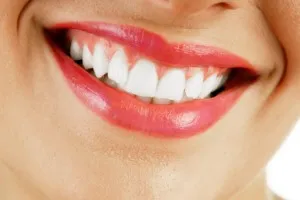According to the American Dental Association (ADA), bleaching is now the most requested dental procedure among people ages 40 to 60.
While many of us are on a quest for whiter teeth, standard teeth whitening procedures can have some painful side effects.
All teeth whitening methods include either hydrogen peroxide or carbamide peroxide as active ingredients. Carbamide peroxide breaks down into hydrogen peroxide after a few hours.
The home teeth whitening treatment prescribed by dentists is 10 percent carbamide peroxide, most over-the-counter kits are 15 percent carbamide peroxide, and in-office ‘power bleaching’ sessions are completed using 35 percent hydrogen peroxide.
A survey of 100 people by the University of Southern California School of Dentistry found that half of the subjects experienced mild to moderate tooth sensitivity after using over-the-counter whitening treatments, and 1 in 25 experienced bouts of extreme, debilitating pains, lasting for several minutes each, known by dentists as ‘zingers.’
Dentists have also reported seeing gum irritation, uneven whiteness, and bluish, translucent enamel (which can be permanent in some people, especially after excessive whitening) in patients following whitening treatments.
If you have any health problems in your mouth, however, side effects may be more severe. If the whitening gel seeps into an unfilled cavity, cracked tooth or sore in your mouth, it may cause severe, internal pain, and sometimes the need for a root canal.
‘Power bleaching’ treatments can be especially painful, as the hydrogen peroxide concentration is so strong. According to John W. Siegal, a New York City dentist, “with these techniques, there have been reports of increased sensitivity of the pulp chamber in the middle of the tooth.”
Dentists explain that there is no certainty of avoiding tooth sensitivity after these treatments, and patients have reported it lasting from several days up to three months after a treatment.
Luckily, there are ways to obtain a whiter smile while avoiding the potential complications of chemical treatments. Baking soda is one time-tested method. For one week, dip a toothbrush with natural toothpaste (or just mix baking soda and water to make a thick paste) into a small dish of baking soda and brush as you normally would, taking extra care to target the teeth that are the most visible.
After a week of brushing with baking soda, however, give your teeth a break and brush as normal, using a natural toothpaste, for a couple of months, as using baking soda too often may cause damage to tooth enamel.

Including raw, crispy, organic fruits into your meals can also help to remove stains from your teeth, as they are naturally abrasive. Cosmetic dentist Arthur Glosman says, “they’re like nature’s toothbrush.”
Eating organic strawberries can also help keep teeth white, as they contain malic acid, which has been found to help remove stains, as well as vitamin C, which helps remove plaque.
These natural techniques, plus brushing your teeth at least twice a day and flossing daily, can help you get the healthy, white smile that you want, without bleaching.
-The Alternative Daily
Sources:
http://www.prevention.com/beauty/beauty/dangers-teeth-whitening
http://www.huffingtonpost.com/2011/05/20/natural-tooth-whiteners_n_864546.html
http://www.mindbodygreen.com/0-9457/5-non-toxic-ways-to-whiten-your-teeth.html
